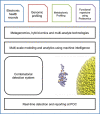Sepsis in the era of data-driven medicine: personalizing risks, diagnoses, treatments and prognoses
- PMID: 31190075
- PMCID: PMC8179509
- DOI: 10.1093/bib/bbz059
Sepsis in the era of data-driven medicine: personalizing risks, diagnoses, treatments and prognoses
Abstract
Sepsis is a series of clinical syndromes caused by the immunological response to infection. The clinical evidence for sepsis could typically attribute to bacterial infection or bacterial endotoxins, but infections due to viruses, fungi or parasites could also lead to sepsis. Regardless of the etiology, rapid clinical deterioration, prolonged stay in intensive care units and high risk for mortality correlate with the incidence of sepsis. Despite its prevalence and morbidity, improvement in sepsis outcomes has remained limited. In this comprehensive review, we summarize the current landscape of risk estimation, diagnosis, treatment and prognosis strategies in the setting of sepsis and discuss future challenges. We argue that the advent of modern technologies such as in-depth molecular profiling, biomedical big data and machine intelligence methods will augment the treatment and prevention of sepsis. The volume, variety, veracity and velocity of heterogeneous data generated as part of healthcare delivery and recent advances in biotechnology-driven therapeutics and companion diagnostics may provide a new wave of approaches to identify the most at-risk sepsis patients and reduce the symptom burden in patients within shorter turnaround times. Developing novel therapies by leveraging modern drug discovery strategies including computational drug repositioning, cell and gene-therapy, clustered regularly interspaced short palindromic repeats -based genetic editing systems, immunotherapy, microbiome restoration, nanomaterial-based therapy and phage therapy may help to develop treatments to target sepsis. We also provide empirical evidence for potential new sepsis targets including FER and STARD3NL. Implementing data-driven methods that use real-time collection and analysis of clinical variables to trace, track and treat sepsis-related adverse outcomes will be key. Understanding the root and route of sepsis and its comorbid conditions that complicate treatment outcomes and lead to organ dysfunction may help to facilitate identification of most at-risk patients and prevent further deterioration. To conclude, leveraging the advances in precision medicine, biomedical data science and translational bioinformatics approaches may help to develop better strategies to diagnose and treat sepsis in the next decade.
Keywords: computational medicine; genome informatics; precision medicine; sepsis; translational bioinformatics.
© The Author(s) 2019. Published by Oxford University Press. All rights reserved. For Permissions, please email: journals.permissions@oup.com.
Figures





Similar articles
-
Systemic Inflammatory Response Syndrome.2025 Jun 20. In: StatPearls [Internet]. Treasure Island (FL): StatPearls Publishing; 2025 Jan–. 2025 Jun 20. In: StatPearls [Internet]. Treasure Island (FL): StatPearls Publishing; 2025 Jan–. PMID: 31613449 Free Books & Documents.
-
Management of urinary stones by experts in stone disease (ESD 2025).Arch Ital Urol Androl. 2025 Jun 30;97(2):14085. doi: 10.4081/aiua.2025.14085. Epub 2025 Jun 30. Arch Ital Urol Androl. 2025. PMID: 40583613 Review.
-
Automated monitoring compared to standard care for the early detection of sepsis in critically ill patients.Cochrane Database Syst Rev. 2018 Jun 25;6(6):CD012404. doi: 10.1002/14651858.CD012404.pub2. Cochrane Database Syst Rev. 2018. PMID: 29938790 Free PMC article.
-
[Volume and health outcomes: evidence from systematic reviews and from evaluation of Italian hospital data].Epidemiol Prev. 2013 Mar-Jun;37(2-3 Suppl 2):1-100. Epidemiol Prev. 2013. PMID: 23851286 Italian.
-
Behavioral interventions to reduce risk for sexual transmission of HIV among men who have sex with men.Cochrane Database Syst Rev. 2008 Jul 16;(3):CD001230. doi: 10.1002/14651858.CD001230.pub2. Cochrane Database Syst Rev. 2008. PMID: 18646068
Cited by
-
Integrated Analysis of Gene Co-Expression Network and Prediction Model Indicates Immune-Related Roles of the Identified Biomarkers in Sepsis and Sepsis-Induced Acute Respiratory Distress Syndrome.Front Immunol. 2022 Jun 30;13:897390. doi: 10.3389/fimmu.2022.897390. eCollection 2022. Front Immunol. 2022. PMID: 35844622 Free PMC article.
-
Lactate-albumin ratio improves combined predictive value of qSOFA and MEWS for 30-day mortality in ICU patients with sepsis: A retrospective cohort study.Medicine (Baltimore). 2025 Jul 4;104(27):e43097. doi: 10.1097/MD.0000000000043097. Medicine (Baltimore). 2025. PMID: 40629657 Free PMC article.
-
Tocilizumab attenuates acute lung injury in rats with sepsis by regulating S100A12/NLRP3.Am J Transl Res. 2023 Jan 15;15(1):99-113. eCollection 2023. Am J Transl Res. 2023. PMID: 36777861 Free PMC article.
-
Endotoxin in Sepsis: Methods for LPS Detection and the Use of Omics Techniques.Diagnostics (Basel). 2022 Dec 27;13(1):79. doi: 10.3390/diagnostics13010079. Diagnostics (Basel). 2022. PMID: 36611371 Free PMC article. Review.
-
A hypoxia- and lactate metabolism-related gene signature to predict prognosis of sepsis: discovery and validation in independent cohorts.Eur J Med Res. 2023 Sep 4;28(1):320. doi: 10.1186/s40001-023-01307-z. Eur J Med Res. 2023. PMID: 37661250 Free PMC article.
References
-
- Center for Disease Control . CDC Urges Early Recognition, Prompt Treatment of Sepsis. https://www.cdc.gov/media/releases/2017/p0831-sepsis-recognition-treatme... (9 February 2019, date last accessed).
-
- Torio CM, Moore BJ. National Inpatient Hospital Costs: The Most Expensive Conditions by Payer, 2013: Statistical Brief #204. Healthcare Cost and Utilization Project (HCUP) Statistical Briefs. Rockville (MD), Agency for Healthcare Research and Quality (US), 2006. - PubMed
-
- Angus DC, Linde-Zwirble WT, Lidicker J, et al. Epidemiology of severe sepsis in the United States: analysis of incidence, outcome, and associated costs of care. Crit Care Med 2001;29:1303–10. - PubMed
-
- Lagu T, Rothberg MB, Shieh MS, et al. Hospitalizations, costs, and outcomes of severe sepsis in the United States 2003 to 2007. Crit Care Med 2012;40:754–61. - PubMed
Publication types
MeSH terms
Grants and funding
LinkOut - more resources
Full Text Sources
Medical
Miscellaneous

